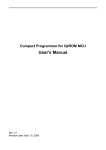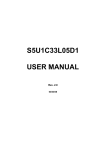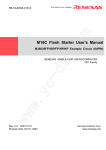Download Voltage Conversion Board User`s Manual
Transcript
To our customers, Old Company Name in Catalogs and Other Documents On April 1st, 2010, NEC Electronics Corporation merged with Renesas Technology Corporation, and Renesas Electronics Corporation took over all the business of both companies. Therefore, although the old company name remains in this document, it is a valid Renesas Electronics document. We appreciate your understanding. Renesas Electronics website: http://www.renesas.com April 1st, 2010 Renesas Electronics Corporation Issued by: Renesas Electronics Corporation (http://www.renesas.com) Send any inquiries to http://www.renesas.com/inquiry. Notice 1. 2. 3. 4. 5. 6. 7. All information included in this document is current as of the date this document is issued. Such information, however, is subject to change without any prior notice. Before purchasing or using any Renesas Electronics products listed herein, please confirm the latest product information with a Renesas Electronics sales office. Also, please pay regular and careful attention to additional and different information to be disclosed by Renesas Electronics such as that disclosed through our website. Renesas Electronics does not assume any liability for infringement of patents, copyrights, or other intellectual property rights of third parties by or arising from the use of Renesas Electronics products or technical information described in this document. No license, express, implied or otherwise, is granted hereby under any patents, copyrights or other intellectual property rights of Renesas Electronics or others. You should not alter, modify, copy, or otherwise misappropriate any Renesas Electronics product, whether in whole or in part. Descriptions of circuits, software and other related information in this document are provided only to illustrate the operation of semiconductor products and application examples. You are fully responsible for the incorporation of these circuits, software, and information in the design of your equipment. Renesas Electronics assumes no responsibility for any losses incurred by you or third parties arising from the use of these circuits, software, or information. When exporting the products or technology described in this document, you should comply with the applicable export control laws and regulations and follow the procedures required by such laws and regulations. You should not use Renesas Electronics products or the technology described in this document for any purpose relating to military applications or use by the military, including but not limited to the development of weapons of mass destruction. Renesas Electronics products and technology may not be used for or incorporated into any products or systems whose manufacture, use, or sale is prohibited under any applicable domestic or foreign laws or regulations. Renesas Electronics has used reasonable care in preparing the information included in this document, but Renesas Electronics does not warrant that such information is error free. Renesas Electronics assumes no liability whatsoever for any damages incurred by you resulting from errors in or omissions from the information included herein. Renesas Electronics products are classified according to the following three quality grades: “Standard”, “High Quality”, and “Specific”. The recommended applications for each Renesas Electronics product depends on the product’s quality grade, as indicated below. You must check the quality grade of each Renesas Electronics product before using it in a particular application. You may not use any Renesas Electronics product for any application categorized as “Specific” without the prior written consent of Renesas Electronics. Further, you may not use any Renesas Electronics product for any application for which it is not intended without the prior written consent of Renesas Electronics. Renesas Electronics shall not be in any way liable for any damages or losses incurred by you or third parties arising from the use of any Renesas Electronics product for an application categorized as “Specific” or for which the product is not intended where you have failed to obtain the prior written consent of Renesas Electronics. The quality grade of each Renesas Electronics product is “Standard” unless otherwise expressly specified in a Renesas Electronics data sheets or data books, etc. “Standard”: 8. 9. 10. 11. 12. Computers; office equipment; communications equipment; test and measurement equipment; audio and visual equipment; home electronic appliances; machine tools; personal electronic equipment; and industrial robots. “High Quality”: Transportation equipment (automobiles, trains, ships, etc.); traffic control systems; anti-disaster systems; anticrime systems; safety equipment; and medical equipment not specifically designed for life support. “Specific”: Aircraft; aerospace equipment; submersible repeaters; nuclear reactor control systems; medical equipment or systems for life support (e.g. artificial life support devices or systems), surgical implantations, or healthcare intervention (e.g. excision, etc.), and any other applications or purposes that pose a direct threat to human life. You should use the Renesas Electronics products described in this document within the range specified by Renesas Electronics, especially with respect to the maximum rating, operating supply voltage range, movement power voltage range, heat radiation characteristics, installation and other product characteristics. Renesas Electronics shall have no liability for malfunctions or damages arising out of the use of Renesas Electronics products beyond such specified ranges. Although Renesas Electronics endeavors to improve the quality and reliability of its products, semiconductor products have specific characteristics such as the occurrence of failure at a certain rate and malfunctions under certain use conditions. Further, Renesas Electronics products are not subject to radiation resistance design. Please be sure to implement safety measures to guard them against the possibility of physical injury, and injury or damage caused by fire in the event of the failure of a Renesas Electronics product, such as safety design for hardware and software including but not limited to redundancy, fire control and malfunction prevention, appropriate treatment for aging degradation or any other appropriate measures. Because the evaluation of microcomputer software alone is very difficult, please evaluate the safety of the final products or system manufactured by you. Please contact a Renesas Electronics sales office for details as to environmental matters such as the environmental compatibility of each Renesas Electronics product. Please use Renesas Electronics products in compliance with all applicable laws and regulations that regulate the inclusion or use of controlled substances, including without limitation, the EU RoHS Directive. Renesas Electronics assumes no liability for damages or losses occurring as a result of your noncompliance with applicable laws and regulations. This document may not be reproduced or duplicated, in any form, in whole or in part, without prior written consent of Renesas Electronics. Please contact a Renesas Electronics sales office if you have any questions regarding the information contained in this document or Renesas Electronics products, or if you have any other inquiries. (Note 1) “Renesas Electronics” as used in this document means Renesas Electronics Corporation and also includes its majorityowned subsidiaries. (Note 2) “Renesas Electronics product(s)” means any product developed or manufactured by or for Renesas Electronics. User’s Manual Voltage Conversion Board User’s Manual RENESAS SINGLE-CHIP 8-BIT CMOS MICROCOMPUTER 740 FAMILY Rev.2.00 2007.07 Table of Contents Chapter 1. Preface .................................................................................................................................................. 1 Chapter 2. Precautions ........................................................................................................................................... 2 Chapter 3. Purpose ................................................................................................................................................. 3 Chapter 4. Power Supply ........................................................................................................................................ 4 4.1. Requirements ............................................................................................................................................... 4 Chapter 5. Layout and Connectivity........................................................................................................................ 5 5.1. Component Layout ....................................................................................................................................... 5 5.2. Board Connectivity ....................................................................................................................................... 6 Chapter 6. Programming......................................................................................................................................... 7 6.1. Introduction ...................................................................................................................................................... 7 6.2. Adjusting a VPP Voltage...................................................................................................................................... 7 6.2.1. Connecting a Voltage Conversion Board .......................................................................................................... 7 6.2.2. Creating a new Project Workspace.................................................................................................................. 8 6.2.3. Connecting Flash Development Toolkit and Adjusting the VPP Voltage ................................................................. 10 6.3. Programming to QzROM ................................................................................................................................... 11 6.3.1. Connecting a Voltage Conversion Board and a Target ....................................................................................... 11 6.3.2. Connecting Flash Development Toolkit........................................................................................................... 11 6.3.3. Programming ........................................................................................................................................... 12 6.3.4. Protect setting .......................................................................................................................................... 12 Chapter 7. Pin Handling ........................................................................................................................................ 14 7.1. Example 1................................................................................................................................................... 14 7.2. Example 2................................................................................................................................................... 15 7.3. Example 3................................................................................................................................................... 16 Chapter 8. Additional Information ......................................................................................................................... 17 ii Chapter 1. Preface Cautions This document may be, wholly or partially, subject to change without notice. All rights reserved. Duplication of this document, either in whole or part is prohibited without the written permission of Renesas Solutions Corporation. Trademarks All brand or product names used in this manual are trademarks or registered trademarks of their respective companies or organisations. Copyright © Renesas Solutions Corp. 2007. All rights reserved. © Renesas Technology Europe Ltd. 2007. All rights reserved. © Renesas Technology Corp. 2007. All rights reserved. Website: http://www.renesas.com/ (Global) http://www.eu.renesas.com/ (Europe) Glossary CPU Central Processing Unit PC Personal Computer FDT Flash Development Toolkit VCB Voltage Conversion Board LED Light Emitting Diode 1 Chapter 2. Precautions Please be sure to read Notes shown below before using this tool. Warning This Voltage Conversion Board is an optional programming tool for QzROM microcontrollers, and cannot be used for Flash microcontrollers. When connecting the Voltage Conversion Board to CPU Board, the Voltage Conversion Board and CPU Board may be damaged. Therefore, do not connect the Voltage Conversion Board to CPU Board contained in Renesas Starter Kit. Warning This Voltage Conversion Board builds in the voltage conversion circuit for VPP supply generation. Therefore, do not connect the Voltage Conversion Board to a User Target with the conversion circuit for VPP supply. Connection with such a User Target, may cause the Voltage Conversion Board and User Target to be damaged. Warning This Voltage Conversion Board has the IDC connector for connecting the E8a and User Target mounted, and these connectors are the same form. Please be sure to connect E8a to the connector “CN2” on Voltage Conversion Board. When connecting the Voltage Conversion Board to connector CN1 on Voltage Conversion Board, the Voltage Conversion Board and E8a may be damaged. >> Please refer to Section 5.2. Warning Before using Voltage Conversion Board, the user must adjust a VPP level using the potentiometer “VR1” on the Voltage Conversion Board. If the Voltage Conversion Board is used without adjusting the VPP level, programming the QzROM microcontroller may not be performed properly. Also, the microcontroller may be damaged. >> Please refer to Section 6.2. 2 Chapter 3. Purpose This Voltage Conversion Board is a programming option tool for Renesas 740 QzROM microcontrollers. Features include: • Programming Circuit. (via E8a emulator) • Voltage Conversion Circuit for VPP Power Supply Generation. This manual describes the technical details of the Voltage Conversion Board hardware. Moreover, this manual provide details of the programming method and programming environment. 3 Chapter 4. Power Supply 4.1. Requirements This Voltage Conversion Board operates from a 3V to 5V power supply. Power is supplied from the E8a or user target system. The Voltage Conversion Board uses this supply to generate VPP supply through a voltage conversion circuit on Voltage Conversion Board. The power jack (J1) for VPP supply generation is provided for the user target system. Normally, the power is provided from E8a or the user target system. If their drive capability is not enough, external power for VPP supply of the user target system can be provided from the power jack. The input voltage range of the external power for VPP supply is 9.0V to 12.0V. Figure 4-1: Power Jack (J1) Polarity 4 Chapter 5. Layout and Connectivity 5.1. Component Layout The following diagram shows the top layer component layout of the board. GND Test Pin (TP1) * Thru-hole E8a Connector (CN2) Target Connector (CN1) Power LED (D2) GND Test Pin (TP2) VPP Adjust (VR1) VPP Power Test Pin (TP4) Power Jack (J1) * Thru-hole * Thru-hole Figure 5-1: Component Layout 5 5.2. Board Connectivity The following diagram shows the board connectivity. Host PC USB cable Voltage Conversion Board Target System TP1 User interface cable Target cable VR1 E8a emulator CN2 TP2 CN1 J1 D2 TP4 QzROM Microcontroller CN1: Target connector CN2: E8a connector J1: Power jack (9to12VDC) D2: Power LED VR1: VPP power adjust TP1, 2: GND test pin (Thru-hole) TP4: VPP power test pin (Thru-hole) Figure 5-2 : Board Connectivity 6 Chapter 6. Programming 6.1. Introduction Renesas’s Flash Development Toolkit is a dedicated flash programming software for Renesas F-ZTAT microcontrollers, which offers a sophisticated and easy-to-use Graphical User Interface. Flash Development Toolkit will have been installed during the installation of the software support for the Renesas Starter Kit product. This manual will describe the stages required to program the code. 6.2. Adjusting a VPP Voltage Before using Voltage Conversion Board, user must adjust a VPP voltage level using the potentiometer “VR1” on the Voltage Conversion Board. If the Voltage Conversion Board is used without adjusting the VPP level, programming the QzROM microcontroller may not be performed properly. Also, the microcontroller may be damaged. Therefore, please be sure to adjust the VPP voltage level according to the procedure shown in the following sections. 6.2.1. Connecting a Voltage Conversion Board This section shows how to connect the Voltage Conversion Board. • Connect E8a to Host PC by the USB cable. • Connect Voltage Conversion Board to E8a by the User interface cable. • Check that the User interface cable is not connected to the Target Connector (CN1) on Voltage Conversion Board. If it is connected, please reconnect with the E8a Connector (CN2) on Voltage Conversion Board. • Check that the user target system is not connected to Voltage Conversion Board. If it is connected, please disconnect the user target system from Voltage Conversion Board. 7 6.2.2. Creating a new Project Workspace • Start Flash Development Toolkit from the Windows Start Menu, Start | All Programs | Renesas | Flash Development Toolkit 4.00 | Flash Development Toolkit 4.00. • Open a new workspace from the [File -> New Workspace…] menu or select ‘Create a new project workspace’ when presented with the ‘Welcome!’ dialog. The example above shows the New Project Workspace dialog. • Enter a Workspace Name; all your files will be stored within a folder called …\Workspaces\<your_name> • The project name field will be pre-filled to match the workspace name above; you can change this name if you wish. • Click <OK> to start the Flash Development Toolkit Project Generator wizard. • Select from a device type list the QzROM microcontroller that you use. • Click <Next>. 8 • Select “E8a” as the communication port. • Click <Next>. • The “Connection Type” dialog will be shown. Click <Next>. • Select “Automatic” as the protection level. • Select “Advanced” as the output massage level. • Click <Finish>. The above Flash Development Toolkit configuration can be changed later using the <Configure Flash Project> button on the toolbar. 9 6.2.3. Connecting Flash Development Toolkit and Adjusting the VPP Voltage • Click the <FDT Connect> button on the toolbar. • Set ‘Power supply’ checkbox. • Select ‘5.0V’. • Press <OK>.’ If connection is completed, Flash Development Toolkit’s Output window will display ‘Connection complete’. Moreover, Power LED (D2) on Voltage Conversion Board lights up. The following step shows the VPP adjustment using the potentiometer (VR1) on Voltage Conversion Board. • Check the voltage level between a GND test pin (TP1 or TP2) and a VPP test pin (TP4) using a tester. • Turn potentiometer and adjust the VPP voltage level to 7.8V – 8.0V (Typ. 7.9V). • When adjustment is completed, click <Disconnect>. • If the dialog shown to the right is displayed, select <No Protection> and click <OK>. This is described in detail by Section 6.2.4. • Close Flash Development Toolkit. Flash Development Toolkit retains a power supply setting until the project is closed. This setting will be initialized by closing a project. After following the steps above, VPP adjustment is complete. 10 6.3. Programming to QzROM 6.3.1. Connecting a Voltage Conversion Board and a Target This section shows how to connect the Voltage Conversion Board to a user target system. • Connect E8a to Host PC by the USB cable. • Connect Voltage Conversion Board to E8a by the User interface cable. • Connect target to Voltage Conversion Board by the Target cable. If you provide the power from the target system, or when you provide the VPP power from the power jack (J1) on the Voltage Conversion Board, please provide the power at this time. 6.3.2. Connecting Flash Development Toolkit • Start Flash Development Toolkit from the Windows Start Menu and open the project workspace created with the Section 6.2.2. • Click the <FDT Connect> button on the toolbar. • If the E8 is to provide the power to the Voltage Conversion Board and user target, select “Power Supply”. Otherwise provide the power supply. • Select “5.0V” or “3.3V” then click <OK> if “Power Supply” is selected, otherwise click <OK>. If connection is completed, Flash Development Toolkit’s Output window will display ‘Connection complete’. Moreover, Power LED (D2) on Voltage Conversion Board lights up. 11 6.3.3. Programming • Right click on the project listed in the left hand pane and select “Add Files…”. • Add the download file. • Double click the download file added to the left hand pane. • Click the <Download Active File> button on the toolbar. The download file will be programmed to the QzROM microcontroller. 6.3.4. Protect setting QzROM also introduces the concept of Security Protection into Flash Development Toolkit, which is optionally set as Flash Development Toolkit disconnects (Note: once set, this cannot be undone). The majority of devices have two levels of protection: Full (which prevents any later reconnection to the device) or None (which allows reconnection normally). Newer devices have more levels – allowing a partial protection of the device and yet still allowing a later connection (but with the protected data region masked). There are three options for the setting of security protection: Automatic Flash Development Toolkit will protect the device as it disconnects. The level of protection will be determined when Automatic is initially selected, typically ‘Full’. If the device offers multiple levels of protection then a dialog will appear to allow the user to select the level that should automatically be applied. 12 Prompt Flash Development Toolkit will ask what to do during the disconnect stage, i.e. whether to protect or not. The choice is between full protection (or other levels if supported by the device) or no protection at all. The default is ‘No Protection’. None Flash Development Toolkit will not protect the device on disconnect. • Select a protect option. • Click the <Disconnect> button on toolbar. If you have selected ‘Prompt’, the dialog shown to the right will be displayed. • Select protection type by this dialog. • Click <OK>. After following the steps above, QzROM programming is completed. 13 Chapter 7. Pin Handling This chapter shows the programming pin handling which is used by the Voltage Conversion Board and E8a. Note that pin handling varies depending on the QzROM microcontroller used. 7.1. Example 1 This Example shows pin handling of 38D5/38D2 Group (OSCSEL=”H”). Figure 7-1 : Example of pin handling 1 VCB Connector 38D5 38D2 CN1 ESCLK (Pin1) P42/SCLK1 P31/SCLK2 ESPGMB (Pin4) P43/SRDY1 P30/SRDY2 ESDA (Pin7) P41/TxD P32/TxD2 Table 7-1: Additional table 1 14 7.2. Example 2 This Example shows pin handling of 38D5/38D2 Group (OSCSEL=”L”) and 3803H/3850A/3858/7544/7545/7546/7547/7548/7549 Group. Figure 7-2 : Example of pin handling 2 VCB Connector 3803H CN1 3850A 38D5 38D2 7544 7545 3858 7546 7547 ESCLK (Pin1) P46/SCLK1 P43/INT2 P42/SCLK1 P31/SCLK2 P12/SCLK P20/INT0 P12/SCLK1 VPP (Pin3) CNVSS CNVSS OSCSEL OSCSEL CNVSS CNVSS CNVSS ESPGMB (Pin4) P47/SRDY1 P40/CNTR1 P43/SRDY1 P30/SRDY2 P10/RxD P06/KEY6 P10/RxD1 ESDA (Pin7) P45/TxD1 P42/INT1 P41/TxD P32/TxD2 P11/TxD P07/KEY7 P11/TxD1 Table 7-2: Additional table 2-1 VCB Connector 7548 --- --- --- --- --- --- CN1 7549 ESCLK (Pin1) P06/SCLK --- --- --- --- --- --- VPP (Pin3) CNVSS --- --- --- --- --- --- ESPGMB (Pin4) P07/SRDY --- --- --- --- --- --- ESDA (Pin7) P10/AN0 --- --- --- --- --- --- Table 7-3: Additional table 2-2 15 7.3. Example 3 This Example shows pin handling of 3823 Group. Figure 7-3 : Example of pin handling 3 16 Chapter 8. Additional Information For details on how to use Flash Development Toolkit, refer to the Flash Development Toolkit manual available on the CD or from the web site. Online technical support and information is available at: http://www.renesas.com/renesas_starter_kits Technical Contact Details America: [email protected] Europe: [email protected] Japan: [email protected] General information on Renesas Microcontrollers can be found on the Renesas website at: http://www.renesas.com/. 17 Voltage Conversion Board User's Manual Publication Date Rev.2.00 Jul.06,2007 Published by: Renesas Solutions Corp. 4-1-6, Miyahara, Yodogawa-ku, Osaka City, 532-0003, Japan ©2007 Renesas Solutions Corp., Renesas Technology Europe Ltd. and Renesas Technology Corp., All Rights Reserved. Voltage Conversion Board User’s Manual 1753, Shimonumabe, Nakahara-ku, Kawasaki-shi, Kanagawa 211-8668 Japan REJ10J1397-0200



































